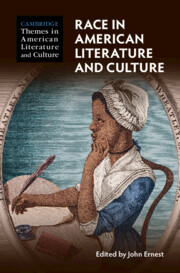Book contents
- Race in American Literature and Culture
- Cambridge Themes in American Literature and Culture
- Race in American Literature and Culture
- Copyright page
- Contents
- Contributors
- Acknowledgments
- Introduction
- Part I Fractured Foundations
- Part II Racial Citizenship
- Part III Contending Forces
- Part IV Reconfigurations
- Part V Envisioning Race
- Chapter 15 Picturing Race
- Chapter 16 “The Man That Was a Thing”
- Chapter 17 Locating Race
- Chapter 18 De-forming and Re-making
- Part VI Case Studies
- Part VII Reflections and Prospects
- Index
Chapter 15 - Picturing Race
African Americans in US Visual Culture before the Civil War
from Part V - Envisioning Race
Published online by Cambridge University Press: 26 May 2022
- Race in American Literature and Culture
- Cambridge Themes in American Literature and Culture
- Race in American Literature and Culture
- Copyright page
- Contents
- Contributors
- Acknowledgments
- Introduction
- Part I Fractured Foundations
- Part II Racial Citizenship
- Part III Contending Forces
- Part IV Reconfigurations
- Part V Envisioning Race
- Chapter 15 Picturing Race
- Chapter 16 “The Man That Was a Thing”
- Chapter 17 Locating Race
- Chapter 18 De-forming and Re-making
- Part VI Case Studies
- Part VII Reflections and Prospects
- Index
Summary
This essay focuses on an archive of nineteenth-century visual images used to protest slavery and claim US citizenship for a group of Black individuals who previously had been denied it. One goal of picturing race in the nineteenth century in illustrated books, almanacs, print publications, paintings, pamphlets, and photography was not only to show the harms of slavery, but also to confer a type of symbolic citizenship onto African Americans, whether free or enslaved, that could be taken into the postbellum era. Yet especially before the war, illustrated works by white abolitionists often replicated binaries in which African Americans were continually in need of a white viewer’s assistance, whereas works by some African Americans undermined ideas of empathy and portrayed African Americans as exhibiting agency and self-determination. Black abolitionists such as Henry Bibb, Frederick Douglass, and Sojourner Truth used visual works to complicate flat portrayals of African American identity, and to play with the notion that such works created truth and captured their subjectivity. Their sophisticated manipulation of visual images exists as a contrast to the dominant culture’s practice of surveilling the bodies of the enslaved and configuring African Americans – whether enslaved or free – as passive and abject.
Keywords
- Type
- Chapter
- Information
- Race in American Literature and Culture , pp. 241 - 261Publisher: Cambridge University PressPrint publication year: 2022

